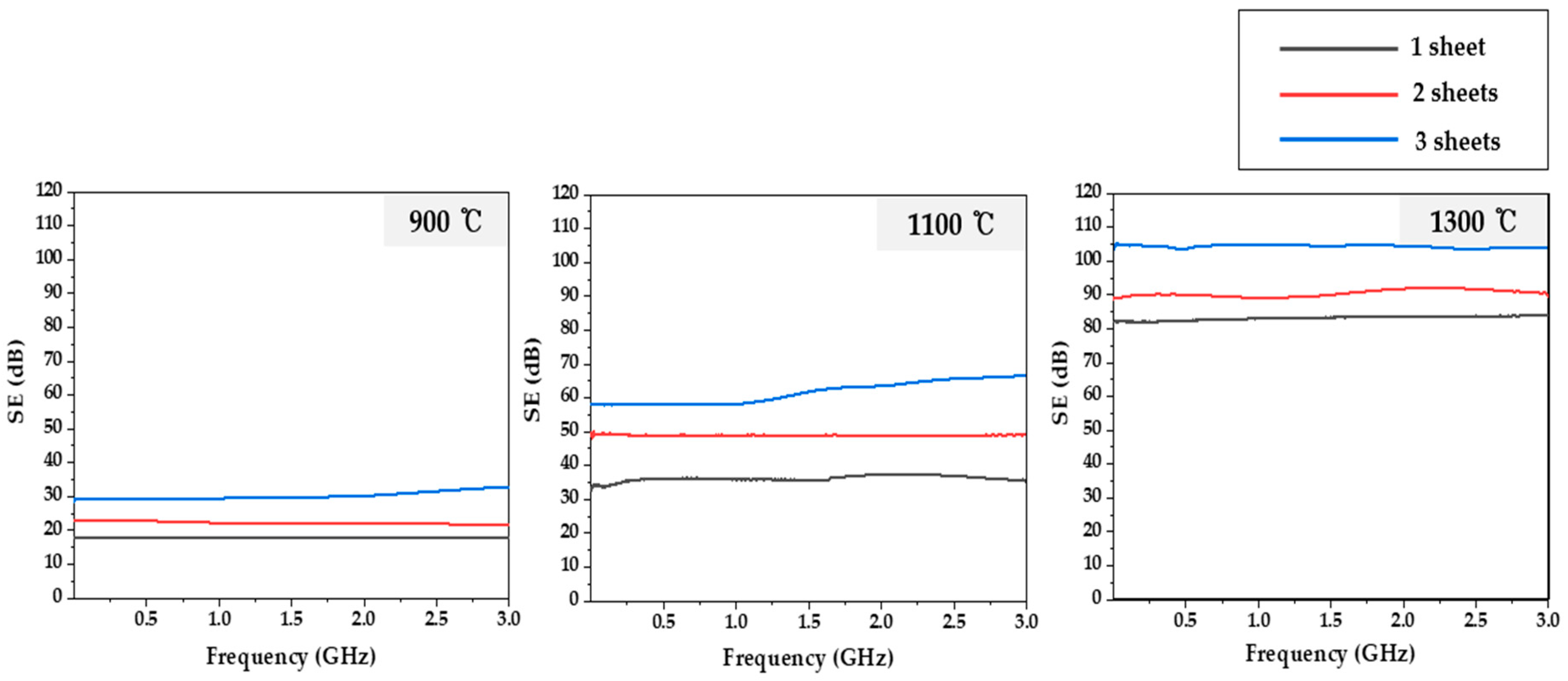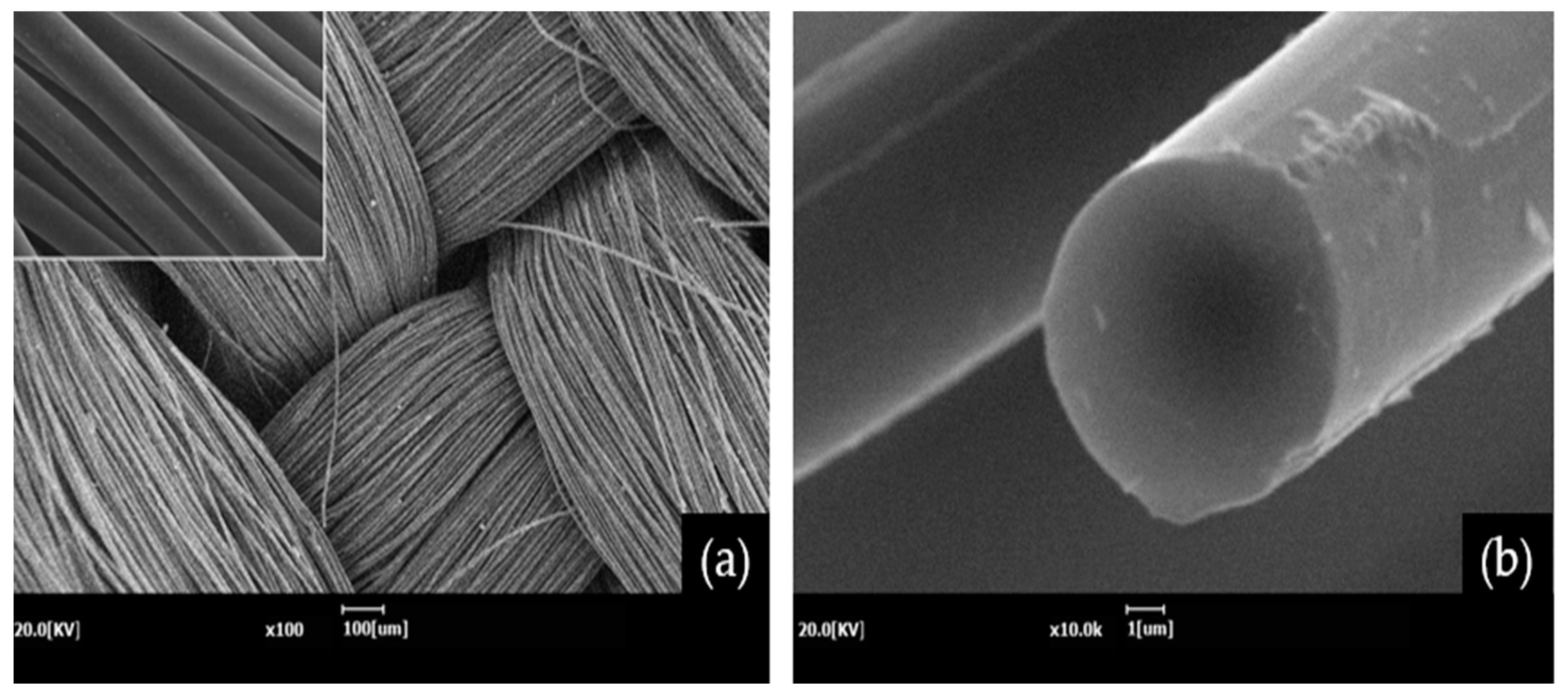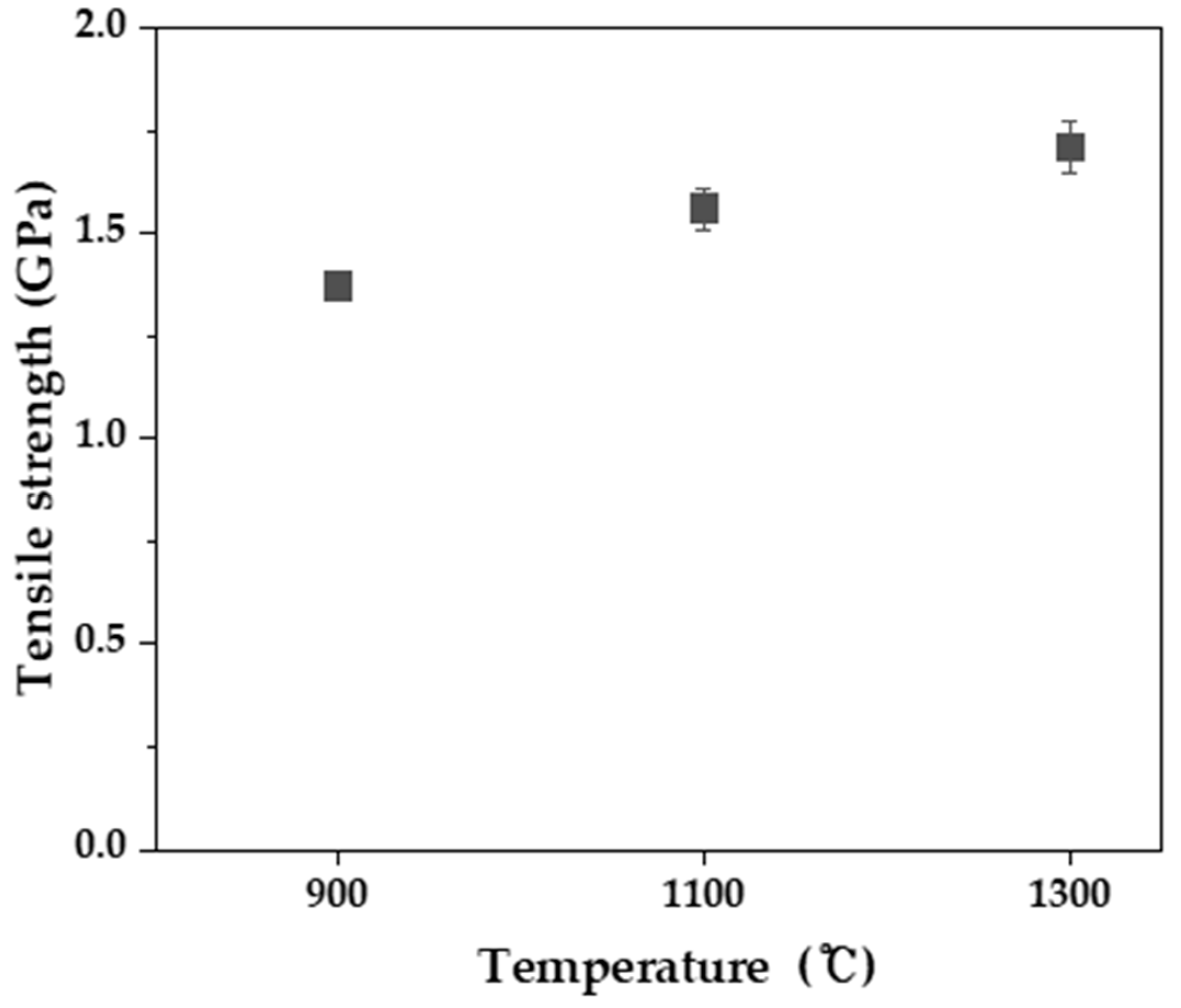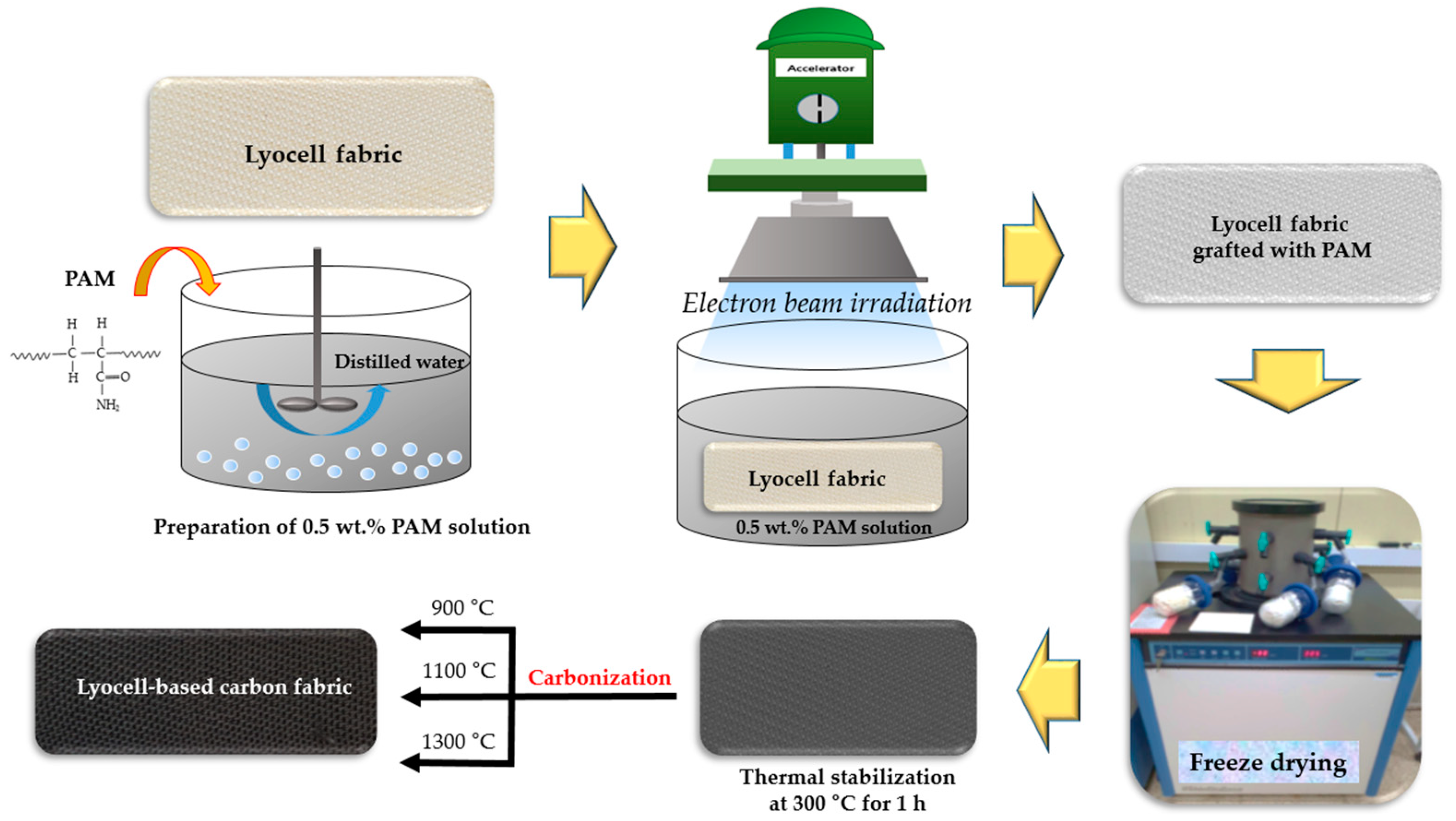Electromagnetic-Interference-Shielding Effectiveness of Lyocell-Based Carbon Fabrics Carbonized at Various Temperatures
Abstract
:1. Introduction
2. Results and Discussion
2.1. X-ray Diffraction and Raman Spectra Studies of Lyocell-Based Carbon Fabrics
2.2. Electrical Conductivity and Electromagnetic Interference Shielding Effectiveness
2.3. Morphology and Mechanical Properties of Lyocell-Based Carbon Fabric
3. Materials and Methods
3.1. Materials
3.2. Preparation of Lyocell-Based Barbon Fabrics
3.3. Characterization
4. Conclusions
Author Contributions
Funding
Institutional Review Board Statement
Informed Consent Statement
Data Availability Statement
Conflicts of Interest
Sample Availability
References
- Kumar, P.; Shahzad, F.; Yu, S.; Hong, S.M.; Kim, Y.H.; Koo, C.M. Large-area reduced graphene oxide thin film with excellent thermal conductivity and electromagnetic interference shielding effectiveness. Carbon 2015, 94, 494–500. [Google Scholar] [CrossRef]
- Yuan, J.; Liu, Q.; Li, S.; Lu, Y.; Jin, S.; Li, K.; Chen, H.; Zhang, H. Metal organic framework (MOF)-derived carbonaceous Co3O4/Co microframes anchored on RGO with enhanced electromagnetic wave absorption performances. Synth. Met. 2017, 228, 32–40. [Google Scholar] [CrossRef]
- Wang, Y.; Zhang, W.; Wu, X.; Luo, C.; Liang, T.; Yan, G. Metal-organic framework nanoparticles decorated with graphene: A high-performance electromagnetic wave absorber. J. Magn. Magn. Mater. 2016, 416, 226–230. [Google Scholar] [CrossRef]
- Das, P.; Deoghare, A.B.; Maity, S.R. Exproring potential of graphene as an EMI shielding material—An overview. Mater. Today 2020, 22, 1737–1744. [Google Scholar]
- Geetha, S.; Satheesh Kumar, K.K.; Rao, C.R.K.; Vijayan, M.; Trivedi, D.C. EMI Shielding: Methods and Materials—A Review. J. Appl. Polym. Sci. 2009, 112, 2073–2086. [Google Scholar] [CrossRef]
- Maruthi, N.; Faisal, M.; Raghavendra, N. Conducting Polymer Based Composites as Efficient EMI Shielding Materials: A Comprehensive Review and Future Prospects. Synth. Met. 2021, 272, 116664. [Google Scholar] [CrossRef]
- Ma, J.J.; Zhan, M.S.; Wang, K. Ultralightweight Silver Nanowires Hybrid Polyimide Composite Foams for High-Performance Electromagnetic Interference Shielding. ACS Appl. Mater. Interfaces 2015, 7, 563–576. [Google Scholar] [CrossRef]
- Yuping, D.; Shunhua, L.; Hongtao, G. Investigation of electrical conductivity and electromagnetic shielding effectiveness of polyaniline composite. Sci. Technol. Adv. Mater. 2005, 6, 513–518. [Google Scholar] [CrossRef]
- Kumar, G.S.; Vishnupriya, D.; Joshi, A.; Datar, S.; Patro, T.U. Electomagnetic interference shielding in 1–18 GHz frequency and electrical property correlations in poly(vinylidene fluoride)-multi-walled carbon nanotube composites. Phys. Chem. Chem. Phys. 2015, 17, 20347–20360. [Google Scholar] [CrossRef]
- Moazen, S.; Sahebian, S.; Haddad-Sabzebar, M. Low percolation behavior of HDPE/CNT nanocomposites for EMI shielding application: Random distribution to segregated structure. Synth. Met. 2021, 281, 116900. [Google Scholar] [CrossRef]
- Gao, J.; Wang, L.; Guo, Z.; Li, B.; Wang, H.; Luo, J.; Huang, X.; Xue, H. Flexible, superhydrophobic, and electrically conductive polymer nanofiber composite for multifunctional sensing applications. Chem. Eng. J. 2020, 381, 122778. [Google Scholar] [CrossRef]
- Zhao, B.B.; Li, X.; Zeng, S.; Wang, R.; Wang, L.; Che, R.; Zhang, R.; Park, C.B. Highly compressible polymer composite foams with thermal heating-boosted electromagnetic wave absorption abilities. ACS Appl. Mater. Interfaces 2020, 12, 50793–50802. [Google Scholar] [CrossRef] [PubMed]
- Naji, A.; Krause, B.; Potschke, P.; Ameli, A. Hybrid conductive filler/polycarbonate composites with enhanced electrical and thermal conductivities for bipolar plate applications. Polym. Compos. 2019, 40, 3189–3198. [Google Scholar] [CrossRef]
- Liao, S.Y.; Wang, X.Y.; Li, X.M.; Wan, Y.J.; Zhao, T.; Hu, Y.G.; Zhu, P.L.; Sun, R.; Wong, C.P. Flexible liquid metal/cellulose nanofiber composites film with excellent thermal reliability for highly efficient and broadband EMI shielding. Chem. Eng. J. 2021, 422, 129962. [Google Scholar] [CrossRef]
- Park, J.; Kwac, L.K.; Kim, H.G.; Shin, H.K. Fabrication and characterization of waste wood cellulose fiber/graphene nanoplatelet carbon papers for application as electromagnetic interference shielding materials. Nanomaterials 2021, 11, 2878. [Google Scholar] [CrossRef] [PubMed]
- Bhosale, S.D.; Gaikwad, S.D.; Gadve, R.D.; Goyal, R.K. Synergistic effects of graphene nanoplatelets on X-band electromagnetic interference shielding, thermal expansion and thermal stability of poly (ether-ketone) based nanocomposites. Mater. Sci. Eng. B 2021, 265, 115038. [Google Scholar] [CrossRef]
- Liu, P.; Yao, Z.; Zhou, J.; Yang, Z.; Kong, L.B. Small magnetic Co-doped NiZn ferrite/graphene nanocomposites and their dual-region microwave absorption performance. J. Mater. Chem. 2016, 4, 9738–9749. [Google Scholar] [CrossRef]
- Aïssa, B.; Sinopoli, A.; Ali, A.; Zakaria, Y.; Zekri, A.; Helal, M.; Nedil, M.; Rosie, F.; Mansour, S.; Mahmoud, K.A. Nanoelectro- magnetic of a highly conductive 2D transition metal carbide (MXene)/Graphene nanoplatelets composite in the EHF M-band frequency. Carbon 2021, 173, 528–539. [Google Scholar] [CrossRef]
- Park, J.; Kwac, L.K.; Kim, H.G.; Shin, H.K. Carbon papers from tall goldenrod cellulose fibers and carbon nanotubes for application as electromagnetic interference shielding materials. Molecules 2022, 27, 1842. [Google Scholar] [CrossRef]
- Pang, Z.; Sun, X.; Wu, X.; Nie, Y.; Liu, Z.; Yue, L. Fabrication and Application of Carbon Nanotubes/Cellulose Composite Paper. Vacuum 2015, 122, 135–142. [Google Scholar] [CrossRef]
- Chen, X.; Liu, H.; Hu, D.; Liu, H.; Ma, W. Recent Advances in Carbon Nanotubes-Based Microwave Absorbing Composites. Ceram. Int. 2021, 47, 23749–23761. [Google Scholar] [CrossRef]
- Lee, T.W.; Lee, S.E.; Jeong, Y.G. Carbon Nanotube/Cellulose Papers with High Performance in Electric Heating and Electromagnetic Interference Shielding. Compos. Sci. Technol. 2016, 131, 77–87. [Google Scholar] [CrossRef]
- Munalli, D.; Dimitrakis, G.; Chronopoulos, D.; Greedy, S.; Long, A. Electromagnetic shielding effectiveness of carbon fibre reinforced composites. Compos. B Eng. 2019, 173, 106906. [Google Scholar] [CrossRef]
- Mikinka, E.; Siwak, M. Recent advances in electromagnetic interference shielding properties of carbon-fibre-reinforced polymer composites—A topical review. J. Mater. Sci. Mater. Electron. 2021, 32, 24585–24643. [Google Scholar] [CrossRef]
- Yim, Y.J.; Lee, J.J.; Tugirumubano, A.; Go, S.H.; Kim, H.G.; Kwac, L.K. Electromagnetic interference shielding behavior of magnetic carbon fibers prepared by electroless FeCoNi-plating. Materials 2021, 14, 3774. [Google Scholar] [CrossRef]
- Jiang, G.; Pickering, S.J.; Walker, G.S.; Wong, K.H.; Rudd, C.D. Surface characterization of carbon bre recycled using uidized bed. Appl. Surf. Sci. 2008, 254, 2588–2593. [Google Scholar] [CrossRef]
- Akonda, M.H.; Lawrence, C.A.; Weager, B.M. Recycled carbon bre-reinforced polypropylene thermoplastic composites. Compos. A Eng. 2012, 43, 79–86. [Google Scholar] [CrossRef]
- Burrow, T. Recent results with lyocell fibers in textiles. Lenz. Ber. 1998, 78, 37–40. [Google Scholar]
- Rosenau, T.; Pottast, A.; Sixta, H.; Kosma, P. The chemistry of side reactions and byproduct formation in the system NMMO/cellulose (Lyocell process). Prog. Polym. Sci. 2001, 26, 1763–1837. [Google Scholar] [CrossRef]
- Carrillo, F.; Colom, X.; Suñol, J.J.; Saurina, J. Structural FTIR analysis and thermal characterization of lyocell and viscose-type fibres. Eur. Polym. J. 2004, 40, 2229–2234. [Google Scholar] [CrossRef]
- Byrne, N.; Chen, J.; Fox, B. Enhancing the carbon yield of cellulose based carbon fibres with ionic liquid impregnates. J. Mater. Chem. A 2014, 2, 15758–15762. [Google Scholar] [CrossRef]
- Mironova, M.; Mokarov, I.; Golova, L.; Vinogradov, M.; Shandryuk, G.; Levin, I. Improvement in carbonization efficiency of cellulosic fibres using silylated acetylene and alkoxysilanes. Fibers 2019, 7, 84. [Google Scholar] [CrossRef] [Green Version]
- Kim, H.G.; Kim, Y.S.; Kuk, Y.S.; Kwac, L.K.; Choi, S.H.; Park, J.; Shin, H.K. Preparation and characterization of carbon fibers from lyocell precursors grafted with polyacrylamide via electron-beam irradiation. Molecules 2021, 26, 2459. [Google Scholar] [CrossRef] [PubMed]
- Shin, H.K.; Jeun, J.P.; Kang, P.H. The characterization of polyacrylonitrile fibers stabilized by electron beam irradiation. Fibers Polym. 2012, 13, 724–728. [Google Scholar] [CrossRef]
- Shin, H.K.; Park, M.; Kang, P.H.; Choi, H.S.; Park, S.J. Preparation and characterization of polyacrylonitrile-based carbon fibers produced by electron beam irradiation pretreatment. J. Indus. Eng. Chem. 2014, 20, 3789–3792. [Google Scholar] [CrossRef]
- Shin, H.K.; Park, M.; Kim, H.Y.; Park, S.J. Influence of orientation on ordered microstructure of PAN-based fibers during electron beam irradiation stabilization. J. Indus. Eng. Chem. 2015, 32, 120–122. [Google Scholar] [CrossRef]
- Bengtsson, A.; Bengtsson, J.; Sedin, M.; Sjöholm, E. Carbon fibers from lignin-cellulose precursors: Effect of stabilization conditions. ACS Sustain. Chem. Eng. 2019, 7, 8440–8448. [Google Scholar] [CrossRef] [Green Version]
- Peng, S.; Shao, H.; Hu, X. Lyocell fibers as the precursor of carbon fibers. J. Appl. Polym. Sci. 2003, 90, 1941–1947. [Google Scholar] [CrossRef]
- Kim, J.D.; Roh, J.S.; Kim, M.S. Effect of carbonization temperature on crystalline structure and properties of isotropic pitch-based carbon fiber. Carbon 2017, 21, 51–60. [Google Scholar] [CrossRef] [Green Version]
- Havigh, R.S.; Chenan, H.M. A comprehensive study on the effect of carbonization temperature on the physical and chemical properties of carbon fibers. Sci. Rep. 2022, 12, 10704. [Google Scholar] [CrossRef]
- Liu, z.; Wang, J.; Li, C.; Zheng, C.; Zhang, B. Remarkable temperature sensitivity of partially carbonized carbon fibers with different microstructures and compositions. Materials 2021, 14, 7085. [Google Scholar] [CrossRef] [PubMed]
- Shen, B.; Li, Y.; Yi, D.; Zhai, W.; Wei, X.; Zheng, W. Strong flexible polymer/graphene composite films with 3D saw-tooth folding for enhanced and tunable electromagnetic shielding. Carbon 2016, 113, 55–62. [Google Scholar] [CrossRef]
- Yao, Y.; Jin, S.; Wang, D.; Wang, J.; Li, D.; Lv, X.; Xhu, Q. Flexible magnetoelectric coupling nanocomposite films with multilayer network structure for dual-band EMI shielding. Compos. Sci. Tech. 2022, 222, 109387. [Google Scholar] [CrossRef]
- Hou, S.; Ma, W.; Li, G.; Zhang, Y.; Ji, Y.; Fan, F.; Huang, Y. Excellent Terahertz shielding performance of ultrathin flexible Cu/graphene nanolayered composites with high stability. J. Mater. Sci. Tech. 2020, 52, 136–144. [Google Scholar] [CrossRef]
- Li, Y.; Liu, J.; Wang, E.; Shen, B.; Chen, J.; Zhang, M.; Zhang, F.; Zhao, J.; Zheng, W. Controllable growth of NiCo compounds with different morphologies and structures on carbon fabrics as EMI shields with improved absorptivity. Carbon 2022, 197, 508–518. [Google Scholar] [CrossRef]
- Bai, W.; Zhai, J.; Zhou, S.; Cui, C.; Wang, W.; Jiang, S.; Cheng, C.; Ren, E.; Xiao, H.; Zhou, M.; et al. Flexible MOF on CoXFe1-XOOH@biomass derived alloy@carbon films for efficient electromagnetic interference shielding and energy conversion. Carbon 2022, 199, 96–109. [Google Scholar] [CrossRef]








Publisher’s Note: MDPI stays neutral with regard to jurisdictional claims in published maps and institutional affiliations. |
© 2022 by the authors. Licensee MDPI, Basel, Switzerland. This article is an open access article distributed under the terms and conditions of the Creative Commons Attribution (CC BY) license (https://creativecommons.org/licenses/by/4.0/).
Share and Cite
Park, J.; Kwac, L.K.; Kim, H.G.; Park, K.-Y.; Koo, K.W.; Ryu, D.-H.; Shin, H.K. Electromagnetic-Interference-Shielding Effectiveness of Lyocell-Based Carbon Fabrics Carbonized at Various Temperatures. Molecules 2022, 27, 5392. https://doi.org/10.3390/molecules27175392
Park J, Kwac LK, Kim HG, Park K-Y, Koo KW, Ryu D-H, Shin HK. Electromagnetic-Interference-Shielding Effectiveness of Lyocell-Based Carbon Fabrics Carbonized at Various Temperatures. Molecules. 2022; 27(17):5392. https://doi.org/10.3390/molecules27175392
Chicago/Turabian StylePark, Jihyun, Lee Ku Kwac, Hong Gun Kim, Kil-Young Park, Ki Woo Koo, Dong-Hwa Ryu, and Hye Kyoung Shin. 2022. "Electromagnetic-Interference-Shielding Effectiveness of Lyocell-Based Carbon Fabrics Carbonized at Various Temperatures" Molecules 27, no. 17: 5392. https://doi.org/10.3390/molecules27175392
APA StylePark, J., Kwac, L. K., Kim, H. G., Park, K.-Y., Koo, K. W., Ryu, D.-H., & Shin, H. K. (2022). Electromagnetic-Interference-Shielding Effectiveness of Lyocell-Based Carbon Fabrics Carbonized at Various Temperatures. Molecules, 27(17), 5392. https://doi.org/10.3390/molecules27175392





